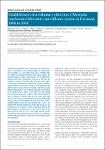Establishment of a voluntary electronic Chlamydia trachomatis laboratory surveillance system in Germany, 2008 to 2014
Dudareva-Vizule, Sandra
Haar, Karin
Sailer, Andrea
Jansen, Klaus
Hamouda, Osamah
Wisplinghoff, Hilmar
Tiemann, Carsten
Pape, Eberhard
Bremer, Viviane
Chlamydia trachomatis (CT) infections are not reportable in Germany and limited data on prevalence are available. CT screening has been offered free of charge to pregnant women since 1995 and to all women under 25 years since 2008. For symptomatic women and men, diagnostic testing is covered by statutory health insurance. We describe the establishment of a nationwide, laboratory-based, voluntary sentinel that electronically collects information on all performed CT tests with test results, test reason and patient information. The sentinel represents one third of all performed CT tests in Germany. In the period from 2008 to 2014, 3,877,588 CT tests were reported, 93% in women. Women aged 20–24 years and men aged 25–29 years were the most frequently tested age groups. The overall proportion of positive tests (PPT) among women was 3.9% and among men 11.0%. The highest PPT among women was in the age groups 15–19 (6.8%) and 20–24 years (5.9%), and among men in the age groups 20–24 (19.2%), 15–19 (15.4%) and 25–29 years (14.8%). The PPT for CT was high among women and men younger than 25 years. Prevention is urgently needed. Monitoring of CT infection in Germany should be continued.
Dateien zu dieser Publikation
Keine Lizenzangabe

